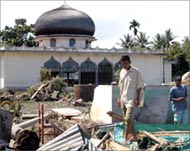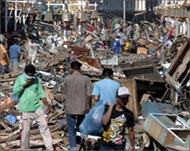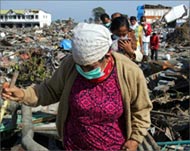Acehnese town that bore tsunami’s brunt
The first witness accounts of the damage Sunday’s tsunami did to communities along the isolated west coast of Indonesia’s Aceh province are coming in.

They appear to support anecdotal reports that a large portion of the 50,000 people in the port town of Muelaboh have perished.
Farmers travelling through Muelaboh on Tuesday on a mission to discover the fate of their children studying in the provincial capital Banda Aceh said most of the town has been reduced to rubble.
“There are only two large buildings left, the army headquarters and the hospital,” according to Jufri, who like many Indonesians uses only one name.
“Everything else is smashed to pieces. You cannot tell where the streets are because of all the rubble. The entire town is as bad as the worst places in Banda Aceh. It does not exist any more.”
Moonscape
The few people who have viewed the town from small aircraft report seeing no signs of life, leading the local media to describe it as a “dead city”. A New Zealand doctor, one of the few Westerners to view Muelaboh from the air, described it as a “moonscape”.
 |
|
Villagers search for belongings in |
Muelaboh and the dozens of small villages that dot the Indian Ocean coastline have been cut off from outside contact since the magnitude 9.0 earthquake struck setting off devastating tsunamis that pounded coastlines as far away as Somalia.
The provincial death toll stands at 78,000 according to the Indonesian ministry of health, a figure that appears certain to rise when authorities finally arrive to properly investigate the destruction on the west coast.
Early estimates suggested 10,000 died in Muelaboh alone but these new witness accounts suggest these are extremely conservative figures.
Roughly 9000 people are believed to have died in the capital alone but vast sections of the city flattened by the tsunami have yet to be excavated and the streets are still littered with rotting corpses.
Damage obvious
Jufri, 47, and his brother Wahid, 55, were among a group of about 120 men who rode motorcycles on a perilous two-day trip across the mountainous interior of Aceh, dodging tigers and separatist rebels to be reunited with their children.
 |
|
People sift through the rubble of |
Their inland village, Abdi, which suffered virtually no damage, is located roughly 100km south of Muelaboh.
Wahid said that half way to the area’s centre, the damage caused by the earthquake became obvious.
The highway was heavily cratered in at least 100 places, he said, and was littered with mud and timber, forcing them to carry their 125cc motorcycles over and around the obstacles.
“When we got to Nakan Raya we found the village had disappeared. Where there used to be homes and shops, there was just dirt and garbage from the ocean,” he said. “There was not a living person and no animals at all. I believe they were all swept into the sea.”
The men reported the next six villages south suffered a similar fate. However, nothing prepared them for the scenes in Muelaboh.
“There were some people there when we arrived, walking around shocked and traumatised,” says Jufri.
“They didn’t seem to even see us. When we talked to them, they said they came from villages up north. We met no one from Muelaboh when we were there.”
Similar fate
Aware the road to Banda Aceh was impassable even for motorcycles, Jufri and his companions traversed the rugged mountainous heart of Aceh to the town of Sigli a stone’s throw from the Malacca Strait.
 |
|
Entire villages along the coastline |
Along the way they found fresh evidence of elephants and tigers, both of which exist in small numbers in the area.
Based on their conversations with people they met in Muelaboh, the men fear that the villages along the 200km of mostly ocean-front road separating Muelaboh and Banda Aceh, which were even closer to the epicentre of the quake, suffered a similar fate.
There are roughly 10 administrative sub-districts along that stretch of coastline each containing between 10 and 15 villages. Some are located in the high country but the majority are found close to the water’s edge.
Both men discovered their children were alive and they have since been moved to a camp for displaced people. The fate of the other children is not known.